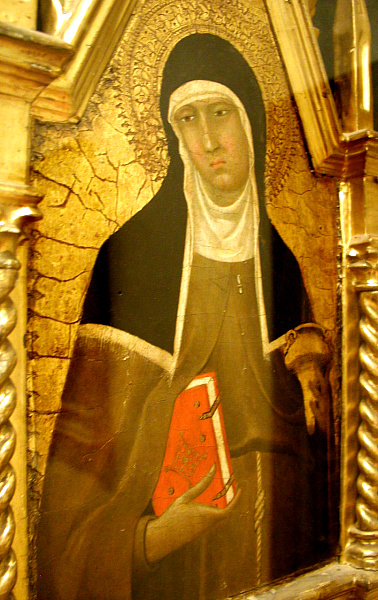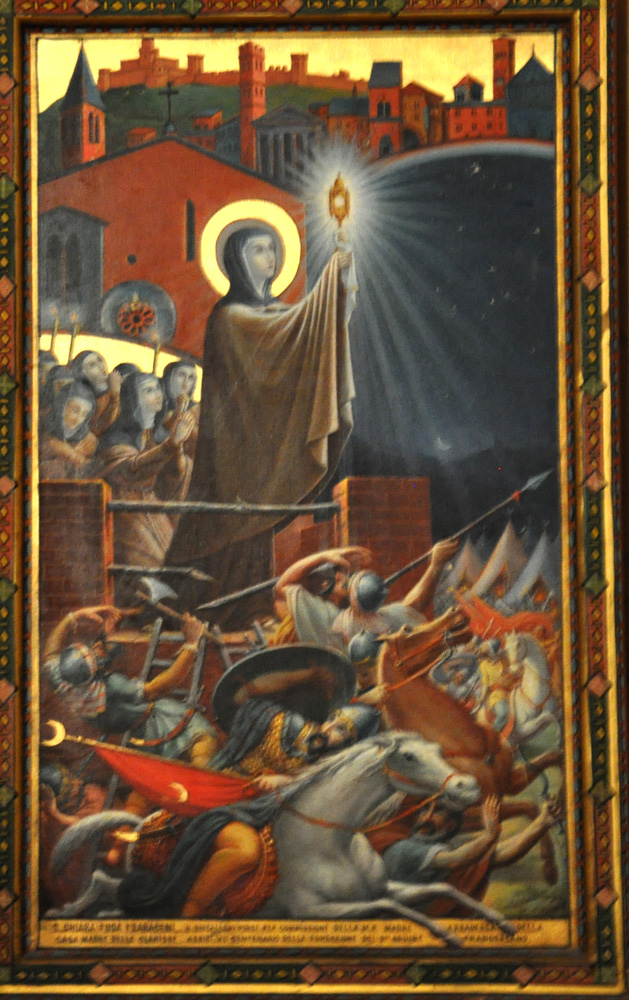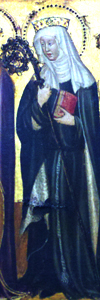NARRATIVE IMAGES
Narrative images are usually based on Thomas of Celano's Life of St. Clare. A 13th-century altarpiece presents eight episodes from that work. The first is also the subject of a painting from the 14th century: On a Palm Sunday the Bishop was distributing palms to the faithful who crowded around the altar rail. Clare stayed back, but the bishop left the sanctuary to hand her a palm branch personally. Taking that as a sign, she secretly left her home that night, met with Francis, and vowed her life to the service of Christ (Life, 13f).
The Life (36-37) tells of a miracle that occurred when Frederick II's Saracen troops had broken into Assisi and were besieging San Damiano, the monastery Clare had founded. She took the Eucharistic Host with her in "a silver casket enclosed in ivory" to the door where the soldiers were trying to beat their way in. At the door she knelt and prayed and then heard the voice of Christ promising to protect the cloister and the city. Soon thereafter, the Saracens retreated from the city. The images of this episode, such as the second picture on the right, heighten the drama by having Clare actually hold the "casket" up before the bedazzled troops and making it look like a blazing lamp.
PORTRAITS
In portraits St. Clare is usually shown in the habit of the "Poor Clares," as at left, and carrying a book and a lamp (as at right) or a stalk of lilies, as in this painting, which like many others pairs her with St. Francis. The lamp refers to her name, the lilies to her virginity. Sometimes she will also have a crozier, as in the third picture at right, to refer to her role as abbess.
Occasionally the attribute will be the lamp-like vessel seen in images of the episode of the Saracen troops (example). Husenbeth reports a French engraving in which the same episode is symbolized by her holding a tall cross fixed in a turban on the ground and trampling on a scimitar.
Prepared in 2014 by Richard Stracke, Emeritus Professor of English, Augusta University, 2015-10-20.
HOME PAGE

Lippo Memmi, St. Clare, circa 1330 (See the description page)

N. Diotallevi, St. Clare Drives Back the Saracens, 1912 (See description page)

Detail from a 15th century predella (See the description page for the predella)
ATTRIBUTES
- Lamp
- Stalk of lilies
- Duchet-Suchaux also reports a cross surmounted with an olive branch, symbolizing her adoration of the crucifix.
MORE IMAGES
- 1535: On a majolica dish from Italy St. Clare hands her lamp to St. Peter.
- Late 18th century: Adobe statue of St. Clare as a Tohono O'odham Indian woman at a mission in Arizona.
DATES
- Feast day: August 12
- Died 1253
BIOGRAPHY
- Thomas of Celano, The Life of St. Clare
- Caxton's Life of St. Clare: html or pdf
- Clare's vita in The Roman Breviary: English translation, III, 815-16; Latin original, 985-86
- Acta Sanctorum, August vol. 2, 739-68